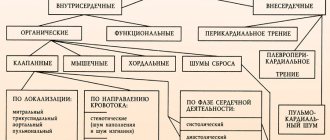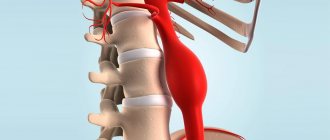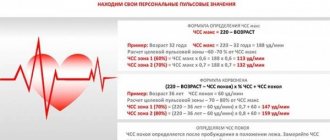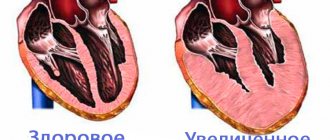Of course, there is no point in paying attention to one-time manifestations of this kind, but if pulsation in the lower abdomen is observed quite often, then it’s time to sound the alarm, however, only a qualified specialist can make an accurate diagnosis after a thorough examination.
In addition, according to the characteristics of pulsation in the lower abdomen (frequency, intensity, presence of painful spasms and localization), it will be possible to make a preliminary diagnosis. In determining the cause of twitching in the lower abdomen, accompanying symptoms are also of great importance, which may indicate a specific systemic disease or temporary disorder. At the same time, it is recommended to pay attention to exactly in which area the pulsation in the lower abdomen is constantly or occasionally felt, the causes of which may depend on this circumstance. Thus, twitching sensations with or without pain can occur either in the left or right region of the lower hypochondrium, or concentrate near the navel.
And first of all, in the presence of any of the above manifestations, a banal intestinal disorder, which is quite easily calculated, should be excluded. In this situation, gases can accumulate in the intestines, the movement of which can put pressure on the vessels, resulting in strong pulsation in the lower abdominal wall. Frequent pulsation in the abdomen often indicates flatulence that has developed as a result of dysbiosis of the large intestine, which occurs due to the “washing out” of beneficial microflora after taking antibiotics or other negative factors. An unnaturally strong pulsation in the navel area may indicate that an inflammatory process is rapidly developing in the body and most likely it will occur in the organs of the digestive system.
We should not exclude helminthic infestation, the long course of which can also provoke obsessive vibration in the peritoneum, although not always painful. At the same time, pulsation in the epigastric region is one of the signs of dysfunction of the ventricles of the heart muscle, so if you notice such manifestations in yourself, it would not hurt to consult a cardiologist. When thinking about what may be twitching in the lower abdomen, it is recommended to pay attention to your menstrual cycle, because if such symptoms are observed during menstruation or shortly before their onset, then there should be no particular reason for panic. The prognosis will be less favorable if regular tremor in the abdomen is accompanied by frequent hiccups and spasms of varying degrees of pain, since we may be talking about some serious problems with the abdominal aorta, which have already become systemic.
And if the tingling and pulsation disappears along with hiccups, then this is another confirmation of the assumption given above. Prolonged or frequent pulsation in the lower abdomen without pain, especially repeated at the same time of day, is a sign of pregnancy, but only in its later stages (starting from the second trimester, although certain exceptions are possible). And most often they are caused by the fact that the baby hiccups in the womb, thereby causing a not so frequent, but clearly perceptible vibration, which does not pose any danger either to the expectant mother or to the fetus developing in her. A shift in vibration to the right side in the absence of pregnancy often indicates certain pathological processes occurring in the patient’s liver.
And first of all, you should undergo an examination through palpation and ultrasound in order to exclude pathological enlargement of this organ. If the liver, like other organs located in the abdominal cavity, turns out to be in perfect order, then you will have to look for the cause of frequent pulsation in the lower abdomen in another pathology. It is noteworthy that we are talking about both a serious illness and a little thing such as constant overeating, which can also provoke tingling, spasms and characteristic pulsation. In addition to overeating, it is not recommended to sit in unnatural positions for a long time, because they can also lead to quite noticeable pulsation in the abdomen.
Pulsation in the area of the abdominal aorta can only mean one thing - an abdominal aortic aneurysm. The process is pathological, characterized by persistent saccular expansion of the largest artery of the body - the aorta due to the thinning of its walls. Abdominal aortic aneurysm is the most common pathology of this vessel. It can be diagnosed in any part of the aorta, but in 90% of all cases it is found in the abdominal part.
The aneurysm itself poses a serious danger. It may rupture or separate, resulting in massive bleeding. An aneurysm is also a predisposing factor for the development of thromboembolism.
Clinic
With pulsation of the abdominal aorta, two scenarios are possible. The pathological process can be completely painless, and the disease will be detected by chance during an ultrasound for another problem. Or the aneurysm will have pronounced clinical signs, causing a large number of problems.
The most common clinical signs of abdominal aortic pulsation or aneurysm include:
- constant pain in the abdomen (mainly in the umbilical region and the left half of the abdomen). Sometimes the pain radiates to the groin area or lumbar spine;
- feeling of “pulse beating” in the stomach. The feeling of pulsation is similar to a heartbeat;
- feeling of heaviness, fullness in the stomach;
- the appearance of pallor in the lower extremities, sometimes their sensitivity is impaired, tingling sensations and “crawling goosebumps” appear;
- in some cases, abdominal syndrome manifests itself (belching, vomiting, lack of appetite). Possible constipation or diarrhea, sudden weight loss.
Treatment
The main treatment method for aortic aneurysm is surgery. If the diameter of the aneurysm does not exceed 5 cm, then surgical treatment may not be indicated. In this case, doctors recommend starting intensive conservative therapy, which is essentially a preventive measure. They are aimed at preventing complications of the disease.
Conservative treatment in this case involves maintaining a healthy lifestyle, quitting smoking and drinking alcoholic beverages, treating arterial hypertension, and lowering blood cholesterol levels. Regular examination and constant monitoring of the condition of the aneurysm is also required.
Surgical intervention
Most often, open surgery is performed. In this case, the surgical approach is exposed along the midline of the abdomen or through the chest (performing a lateral incision). After penetrating the abdominal cavity and exposing the aneurysm, surgeons begin to clamp and sew the prepared special synthetic material to the aorta at the site of the incision in its wall. Prostheses made from this material do not tend to be rejected; they help preserve the basic functions of the aorta throughout the patient’s life. The prognosis for treating abdominal aortic pulsation using this technique is favorable in 90% of cases.
Endovascular surgical treatment is performed less frequently. The main advantage of this method is that it does not require opening the abdominal cavity. The essence of the endovascular technique is to place a special synthetic prosthesis in the area of the aneurysm through a small incision in the groin. The stent is delivered through the femoral artery to the aneurysm under mandatory constant radiological control. The big advantage of this operation is its low degree of invasiveness. The postoperative rehabilitation period rarely exceeds three days, but it is worth remembering that in the immediate postoperative period you will need to undergo regular X-ray examinations regarding the functioning of the implanted stent. This operation is contraindicated for persons with kidney pathologies.
If the body gives sudden signals, this indicates the development of pathological processes. Disturbances in the functioning of the gastrointestinal tract can manifest themselves as sensations of pulsation in the stomach area. The symptom is not a common complaint and appears less often than heartburn, pain, and nausea.
Description
When a sensation of pulsating fluttering in the stomach appears, an experienced specialist will take into account the clinical symptom. Pulsation in the area of the projection of the stomach signals the beginning of a pathological process with frequent manifestations. The feeling of increased pulse in the abdominal muscle spreads to the anterior abdominal wall and brings discomfort to the person. An increased pulse appears in serious pathological conditions of the abdominal wall organs, and in completely healthy people of all age categories.
Throbbing pain can vary in intensity - from mild to sharp pain. Normally, sensations of involuntary contraction occur if you remain in one position for a long time, especially an uncomfortable one. Intense physical activity and sports are provocateurs for the development of discomfort.
Nervous stress is often accompanied by spasms of the muscles of the gastric walls and peritoneum.
Changing positions will relieve tension from the muscles and reduce pressure from the abdominal wall.
To solve the problem, just change the uncomfortable position and lie on your side and relax. These actions will relieve tension from the muscles and reduce pressure from the abdominal wall. If the measures brought a positive result, the pulsation passed without a trace, the condition is not a deviation or a symptom of a dangerous disease. If the upper abdomen is constantly pulsating, the sensations gradually intensify and are accompanied by pain, nausea, you should definitely consult a doctor for advice.
The pulsation after exercise lasts longer, the sensations are localized in one place. But the condition is normal. You can make sure that this is not a consequence of pathology with a light massage of the abdominal muscles. If after these steps the sensations go away, consultation with a specialist is not required.
The stomach is pulsating in different places. Therefore, the pathology of a specific organ is determined by location. If the functioning of the main digestive organ is disrupted, the pulse of the abdominal muscle is felt to the left, just above the navel. Disorders of this organ and intestines are manifested by pulsations in the middle part of the abdomen. This location corresponds to pathological vasodilation, which is characteristic of aortic aneurysms. The pathological condition of the pancreas and its ducts is determined by vibrations in the peri-umbilical zone on the right.
Treatment of abdominal aortic aneurysm
Detection of an abdominal aortic aneurysm is an absolute indication for surgical treatment. A radical type of operation is resection of an abdominal aortic aneurysm followed by replacement of the resected area with a homograft.
The operation is performed through a laparotomy incision. When the iliac arteries are involved in the aneurysm, bifurcation aorto-iliac replacement is indicated.
The average mortality rate for open surgery is 3.8-8.2%.
Contraindications to elective surgery include recent (less than 1 month) myocardial infarction, stroke (up to 6 weeks), severe cardiopulmonary failure, renal failure, widespread occlusive lesions of the iliac and femoral arteries. In the event of a tear or rupture of an abdominal aortic aneurysm, resection is performed for life-saving reasons.
Modern low-traumatic methods of surgery for abdominal aortic aneurysm include endovascular aneurysm replacement using an implantable stent graft. The surgical procedure is performed in a cath lab through a small incision in the femoral artery; The progress of the operation is monitored by X-ray television.
Installation of a stent graft allows you to isolate the aneurysmal sac, thereby preventing the possibility of its rupture, and at the same time creates a new channel for blood flow. The advantages of endovascular intervention are minimal trauma, lower risk of postoperative complications, and rapid recovery.
However, according to the literature, distal migration of endovascular stents is observed in 10% of cases.
www.krasotaimedicina.ru
There are no medications that can eliminate an aneurysm. But the patient should still take the medications prescribed by the doctor to prevent high blood pressure, which can cause the aneurysm to rupture, and to prevent further damage to the vascular wall. The following groups of drugs are prescribed:
- cardiotropic drugs - Prestarium, Recardium, verapamil, Noliprel, etc.
- anticoagulants and antiplatelet agents (drugs that prevent the formation of blood clots) - cardiomagnyl, thromboAss, aspicor, warfarin, clopidogrel. They should be prescribed with caution, as rupture of the aneurysm contributes to further bleeding.
- lipid-lowering drugs (atorvastatin, rosuvastatin, etc., see statins - harm or benefit) normalize cholesterol levels in the blood, preventing its deposition on the walls of blood vessels (
- antibiotics and antifungals for inflammatory processes in the aorta.
- anti-inflammatory drugs (NSAIDs - diclofenac, corticosteroids - prednisolone) for rheumatic damage to the heart and aorta.
- medications aimed at correcting glucose levels in diabetes mellitus, etc.
Effective treatment of the disease is carried out only by surgery. The operation can be performed on a planned or emergency basis.
The indication for elective surgical intervention is an uncomplicated aneurysm larger than 5 cm. Emergency surgery is performed for aortic dissection or rupture.
In both cases, the operation is performed under general anesthesia with the connection of a heart-lung machine. An incision is made in the anterior abdominal wall with access to the abdominal aorta. After this, the surgeon applies clamps above and below the protrusion, excises the walls of the aneurysm and sutures an artificial prosthesis to the intact areas of the aorta above and below the aneurysm.
The prosthesis is a synthetic tube that takes root well in the body and does not require replacement throughout a person’s life. Sometimes a prosthesis, bifurcated at the end, is used to replace the aorta below the site of its bifurcation in case of damage to the iliac arteries. The operation lasts about 2 – 4 hours.
Treatment of an abdominal aortic aneurysm does not imply the use of drugs, since in this case they do not exist, however, the drugs should be used as prescribed by a doctor if certain abnormalities in the human body require it. The main ones include:
- cardiotropic – prevent the formation of blood clots (Prestarium, Verapamil);
- lipid-lowering agents – normalizing cholesterol levels, which significantly reduces the amount of cholesterol deposits (Atorvastatin, Rosuvastatin).
The effectiveness of treatment for abdominal aortic aneurysm disease is achieved exclusively by surgical treatment if the aneurysm has already ruptured tissue and exceeds 5 cm in size. In this case, the operation can be planned or emergency.
The first type is carried out with timely diagnosis and treatment of abdominal aortic aneurysm. During the preparatory period, a thorough examination of the abdominal aortic aneurysm and treatment is carried out to prevent exacerbation or complication of the disease.
Emergency surgery is necessary when dissecting aneurysms begin to rupture and the patient's life is at risk. The operating process is carried out without preliminary preparation of the ruptured internal area of the vessel, which increases the risk of death.
The operation is performed under general anesthesia using a heart-lung machine.
This method of treating the disease has a number of contraindications, for example:
- in case of detection of an acute form of myocardial infarction;
- chronic heart failure;
- impaired liver and kidney function;
- surgical pathologies;
- elevated blood sugar and bronchial asthma.
The main thing in treatment is to choose the right tactics and not cause harm through your actions. General tips on this matter are:
- Small aneurysms (up to 5 cm), which, according to ultrasound or other research methods, do not increase, or the increase does not exceed 0.3 cm in 6 months, do not need to be operated on. Constant monitoring is carried out.
- Large (6–10 cm or more) and abdominal aortic aneurysms, increasing at a rate of 0.5 cm in 6 months, it is advisable to operate as quickly as possible. High risk of rupture.
- It is better not to operate on aneurysmal enlargements located above the renal arteries without significant indications (rapid enlargement of the aneurysm in young people and people under 55–65 years of age without concomitant pathology).
- For people over 70–75 years of age, especially in the presence of severe concomitant diseases, it is very dangerous to operate on any aneurysms. Conservative-observational tactics are more appropriate.
The essence of the operation
General treatment recommendations
The presence of an abdominal aortic aneurysm in a patient is an indication for surgical treatment, especially if the size of the protrusion increases by more than 0.4 cm per year.
The main operation for an abdominal aortic aneurysm is aneurysmectomy (excision of the aneurysmal sac) followed by plastic surgery of the removed portion of the blood vessel with a prosthesis made of Dacron or other synthetic material.
Surgical intervention is performed through a laparotomy approach (an incision in the abdominal wall). If the iliac arteries are also involved in the pathological process, then bifurcation aorto-iliac replacement is performed.
Before, during and on the first day after surgery, the pressure in the cardiac cavities and the magnitude of cardiac output are monitored using a Swan-Gantz catheter.
Contraindications to performing elective surgery for abdominal aortic aneurysm are:
- acute cerebrovascular accidents;
- fresh myocardial infarction;
- end-stage chronic renal failure;
- severe degree of cardiac and respiratory failure;
- widespread occlusion of the iliac and femoral arteries (partial or complete blockage of blood flow through them).
If an abdominal aortic aneurysm ruptures, the operation is performed for life-saving reasons on an emergency basis.
Currently, vascular surgeons prefer minimally invasive methods for treating abdominal aortic aneurysm. One of them is endovascular prosthetics of the area of pathological expansion using an implantable stent graft (a special metal structure).
The stent is installed so that it completely covers the entire length of the aneurysmal sac. This leads to the fact that the blood stops putting pressure on the walls of the aneurysm, thereby preventing the risk of its further enlargement, as well as rupture.
This operation for abdominal aortic aneurysm is characterized by minimal trauma, a low risk of complications in the postoperative period, and a short rehabilitation period.
The normal diameter of the aorta in the abdominal cavity is about two centimeters in diameter; aneurysmal dilations can significantly exceed the permissible norms, reaching critical sizes.
Dilations of less than 5 cm rarely cause rupture, so surgery is not necessary. But it should be noted that this disease does not go away on its own; in most cases, surgical intervention is required over time.
In order for the disease to progress and the aneurysmal expansion not to grow in size, the patient must be under the supervision of a doctor to prevent the development of an abdominal aortic aneurysm.
Every six months, an ultrasound and CT scan is performed to monitor the condition and size of the aneurysm. Blood pressure must be corrected and antihypertensive drugs are prescribed for this purpose.
Only following all the doctor’s instructions and timely research can make it possible to monitor the patient’s condition and carry out surgical intervention in a timely manner.
Abdominal aortic aneurysm larger than 5 cm is treated only surgically. Such dilations are often complicated by rupture, which requires immediate surgical intervention, otherwise the rupture will be fatal.
But even with immediate intervention, the mortality rate is 50%. Therefore, as soon as the symptoms of an abdominal aortic aneurysm are identified and the appropriate diagnosis is made, it is so important to be under observation, and in case of further dilation of the vessel, to perform the operation in a timely manner.
Today, there are two types of surgical treatment, but only a doctor can decide which one is more suitable for the patient, taking into account his condition, lifestyle and other factors. Both types of surgical treatment are based on the implantation of an artificial vessel to restore normal blood circulation through the damaged area of the aorta.
Traditional surgical treatment of abdominal aortic aneurysm involves implantation of an artificial vessel made of plastic material inside the dilated aorta. The aorta seems to envelop the implant with its tissues.
The entire operation is performed through an incision in the abdominal cavity and lasts about 6 hours. With radical treatment, 90% of operated patients have a favorable prognosis.
The second type of treatment is the endovascular insertion of a stent-graft, a special device with which the aneurysmal sac is isolated from the general bloodstream. In this way, a possible rupture of the thinned wall is prevented and a new path for blood flow is created.
With this type of surgery, the implant is inserted through a puncture in the groin area. At the junction of the femoral vessels, a special catheter is inserted, through which the device is inserted directly into the aneurysm, where the stent graft opens and forms a channel for normal blood flow.
This operation takes from 2 to 5 hours and is a good alternative to the traditional method, especially for patients with a high risk of complications during surgery. But such treatment is contraindicated in patients with pathology of the arteries of the kidneys and other organs.
Endoprosthesis replacement has no contraindications due to age, and is much easier to tolerate for elderly patients than open surgery.
Modern low-traumatic methods of surgery for abdominal aortic aneurysm include aortic replacement using an implantable stent graft. The surgical procedure is performed in a cath lab through a small incision in the femoral artery; The progress of the operation is monitored by X-ray television.
Installation of a stent graft allows you to isolate the aneurysmal sac, thereby preventing the possibility of its rupture, and at the same time creates a new channel for blood flow. The advantages of endovascular intervention are minimal trauma, lower risk of postoperative complications, and rapid recovery.
However, according to the literature, distal migration of endovascular stents is observed in 10% of cases.
Causes of pulsation in the stomach
Gastric pulsation occurs with the development of many gastrointestinal diseases. But it is possible for a symptom to appear due to third-party pathologies that irradiate to the area of the projection of the stomach. Pulsation appears more often after eating and is accompanied by pain. The pain can be sharp, shooting, periodic, constant, aching. Often the reasons are physiological in nature. Provoking factors:
- Gastritis in acute or chronic aggravated condition.
- Tumor processes. Often, the presence of an increased pulse at the top of the anterior abdominal wall allows one to suspect cancer.
- Vascular changes. When the aorta narrows, which is often accompanied by atherosclerosis, the pressure inside the vessel increases, the blood flow is turbulent with an increase in pulse. In this case, the walls of the vessel gradually lose their elasticity, which prevents them from maintaining normal blood flow pressure. As a result, the person begins to feel a strong pulse.
- Formed aneurysm of the main vessel - the aorta. It is located in the retroperitoneal space. An aneurysm is characterized by persistent expansion with stretching of the aortic walls in one area. This happens due to morphological and functional changes in the walls. Aneurysms come in different shapes and sizes, most often sac-shaped or fusiform. In this case, the age group of patients is 60 years and older. The aneurysm manifests itself as a pulsation in the middle part of the abdomen. Additionally, with an aneurysm, pain, belching, and bloating appear. The patient begins to lose weight.
- Reduction in the diameter of the abdominal aorta without the formation of an aneurysm. The reason is the hardening of the walls of the aorta, which causes plaques to appear and pressure inside the blood vessels to increase. When blood flows through a constricted area under pressure, there is resistance to its flow. Therefore, pulsation of the peritoneum occurs.
- Pancreatitis. Usually, an increased pulse in the upper part of the abdominal wall is accompanied by severe girdle pain, heaviness, and a change in the state of ulcers during bowel movements.
- Liver pathologies. The organ may pulsate with visible enlargement, with the development of cirrhosis, hepatitis, and cholestasis.
- Dysfunction of the heart muscle. The upper abdomen pulsates with persistent diffuse expansion or thickening of the wall of the right ventricle of the heart, which is located above the xiphoid process. Increased fluttering is felt in the epigastric region.
- Mental disorders, central nervous system dysfunctions. Constant exposure to stress and psycho-emotional stress negatively affects the body, causing many pathological processes.
When overeating, the stomach works intensively, which causes pulsation.
In other cases, the reasons are physiological:
- Thin and tall. People of the asthenic type often feel a strong pulse in the upper abdomen due to the proximity of the aorta. This phenomenon is considered normal.
- Prolonged stay in an uncomfortable position, physical activity with muscle strain. The symptom is relieved by rest and light massage.
- Binge eating. Excess food in the stomach cavity causes the organ to work intensively, which causes pulsation.
- Hiccups. During shudders and sudden contractions of the diaphragm, sensations can be transmitted to the epigastric region.
- Early pregnancy. During this period, strong changes occur in all organs and systems of the body, especially in the blood vessels. Therefore, pulsation can accompany a pregnant woman until delivery. But in most cases, the reason lies in hiccups and slight movements of the fetal limbs.
Sometimes it pulsates in the upper part of the peritoneum in the morning on an empty stomach. This may be caused by spasms of the diaphragm, which is similar in mechanism to hiccups. The etiology of the condition is explained by the reflux of stomach acid into the esophagus passing through the diaphragm. The process is aggravated by the horizontal position. When a person wakes up and begins to move, the tissues irritated by the acid contract. The duration of the sensation depends on the time of exposure to the stimulus. Often the process is accompanied by heartburn or regurgitation.
Pulsating sensations occur due to cardiac arrhythmia when body position changes during sleep. If pressure is applied to the heart area, the pulsation can last several minutes and radiate to the epigastric zone.
If the patient complains that something is moving in his stomach, then this is a slightly inaccurate description of the problem. Worms in the stomach can cause increased gas formation (flatulence), hence the sensation of movement. In fact, a person feels gas bubbles moving through the intestines.
Important! It has been proven that even a worm up to 40 m long (tapeworm) cannot give a sensation of movement and pulsation in the abdominal cavity. Usually patients do not even suspect about helminthic infestation.
If a person thinks that something is moving in his stomach, then against the background of helminthic infestations this can be caused by severe intoxication of the body with metabolic products of worms or toxins that are released during the decomposition of dead individuals.
Many worms live in the intestines and feed on the food that a person eats. In this case, the patient lacks nutrients and may eat excessively, which contributes to digestive disorders and similar sensations.
Pathogenesis of the disease
An abdominal aortic aneurysm can begin to bother a person due to the inflammatory and degenerative changes that appear on the walls of the aorta. Both types of processes cause wall thickening. The patient may be diagnosed with perianeurysmal or postaneurysmal fibrosis, which develops quite quickly. In addition, patients often experience fusion of organs, which, with the intensive development of the disease, also become subject to a general inflammatory process.
Pulsation in the abdomen
According to experts, pulsation in the abdomen is not directly related to helminthic infestations, but against the background of pathologies of the digestive system, which can be caused by worms, such sensations can bother the patient.
By the way it pulsates in the stomach and where this sensation is localized, one can judge the cause of this phenomenon:
- Pulsation on the right side, slightly closer to the center of the abdomen, may indicate pathologies of the pancreas, as well as the vessels of this organ.
- If this feeling is localized a little to the left of the center line of the abdomen, then we can make the assumption that the stomach is pulsating.
- Pulsation in the abdomen, namely in its central part, can also indicate pathologies of the stomach or intestines.
Important! Do not neglect the pulsation, since the problem may be associated with vasodilation, for example, with an aortic aneurysm. In this case, you need to contact a specialist.
It is equally important to remember what you were doing before such sensations appeared. This can happen after overstraining the abdominal muscles, for example, after playing sports. In this case, a light massage and rest will help get rid of unpleasant sensations.
Causes
The sensation of pulsation can appear in various diseases. Most often, the reasons for this may be associated with the following conditions and diseases:
If the pulsation is localized in the stomach, then most often this is a temporary problem, since this organ is fed by the vagus nerve and this picture can be caused by temporary neurological abnormalities.
Worth knowing! Often a similar symptom occurs in patients with vegetative-vascular dystonia.
Sometimes such pulsations in the stomach occur when overeating. This is explained by the fact that when eating a large amount of food, the walls of the stomach become overstretched. In this case, nerve impulses from the nerves inside the wall turn on the reverse mechanism through the vagus nerve. Because of this, the motility of the organ increases and pulsation appears.
With gastritis with high acidity, a spasm of the pylorus is observed, in which food does not pass further into the intestine, but is retained in the stomach. In this case, the natural motility of the organ provokes such a symptom.
Characteristic features of the disease
An abdominal aortic aneurysm is considered a pathological phenomenon; cardiologists note the fact of the constant development of this disease in patients suffering from an aneurysm. As practice shows, the abdominal part suffers in a large number of patients, practically in 95% of all patients. Men over 60 often suffer from this disease; almost 5% of them suffer from the disease. If at an early stage an aneurysm of the abdominal aorta occurs without any manifestations, with time of its development and progression the patient begins to feel discomfort, which occurs due to an increase in the affected area by 10% annually. Over time, the area of the aorta with the aneurysm becomes thinner, further leading to rupture and poor outcome. In Russia, this disease is in 15th place among all diseases that most often cause death in a patient.
Your actions
If unpleasant symptoms appear for the first time, then you don’t have to do anything to begin with. Perhaps this is a temporary phenomenon associated with overexertion, stress or hemostasis, which will go away on its own. You probably drank alcohol the day before or overate, which means everything will go away after digestion normalizes.
If symptoms recur or do not subside, you should consult a specialist. In this case, it is advisable to take tests to detect helminths, as well as visit a gastroenterologist and therapist.
It is impossible not to pay attention to pulsating colic in any part of the abdomen. This unpleasant symptom, which can appear on the left, lower or right in the abdominal cavity, can be an indicator of various pathologies, and therefore requires mandatory measures aimed at finding and eliminating its causes and preventing unpleasant consequences. The article discusses answers to the questions: why does throbbing pain appear in the abdominal cavity, why does it hurt in the lower abdomen and pulsates in the intestinal area.
How is celiac stenosis manifested and treated?
The abdominal aorta at the intersection of the diaphragm may be subject to compression by the diaphragmatic ligament or pedicles in the area of origin of the celiac trunk. This disease is called Dunbar's compression stenosis syndrome.
Signs depend on the malnutrition of the abdominal organs: constant pain, indigestion, general weakness and fatigue. Sometimes it occurs without clear clinical signs. In case of severe ischemia of the abdominal cavity, surgical treatment is performed.
A little about the history of the discovery
Ischemic disease of the abdominal type was previously attributed only to manifestations of atherosclerosis of the abdominal artery. The American surgeon Dunbar, based on his experience in treating such patients, discovered compression of the celiac arterial trunk by the diaphragmatic median ligament. And then other factors were identified that disrupt blood flow in this area.
Due to the prevalence of this pathology, the disease is classified as a separate nosological form of circulatory diseases.
Throbbing pain in the lower abdomen on the right, left abdomen, what are the causes of abdominal pain in the form of pulsation?
Pulsating, pulsating pain is a symptom that can overtake absolutely anyone. It is often very difficult to bear. Diseases that have just such pain as a symptom can be safely rated at seven points on a ten-point scale. It should be borne in mind that the stomach refers to a part of the human body, while it contains organs of different systems that are of great importance in human life. The abdomen contains the organs of the digestive system, the gallbladder and the organs of the genitourinary system. The structure, tissue and purpose of these organs differ, as does the severity of the diseases that cause pain in them. Because of this, unpleasant sensations of the same strength, but in different parts of the abdominal cavity, can have different sources.
In both sexes, painful symptoms in the lower abdomen in many cases signal problems with the genitourinary system. Under the influence of inflammation and injuries of internal organs, obstructions in the patency of the pathways that carry waste products, their blockage occurs. This worsens a person's health and can sometimes be life-threatening. If alarming symptoms are detected in the peritoneum, when pain appears in the form of pulsation in the abdomen, it is imperative and without delay to seek advice from a specialist. Pain that does not stop for more than half an hour requires special attention.
If there is throbbing pain in the lower abdomen on the right, left abdomen, then the basic rule is to under no circumstances try to endure the pain accompanied by pulsation, especially if it is very strong. There is a good chance that the causes of throbbing pain in the lower abdomen, on the left or right side of the abdomen, in the center of the abdomen, or when throbbing and pain in the abdomen in the upper part may indicate the development of certain serious pathologies, dangerous diseases.
Disease classifier
According to the international classification, there are many types of this disease. An abdominal aortic aneurysm can be infrarenal (localized below the renal arteries) or suprarenal (above the specified location).
If we consider the disease in relation to the shape of the protrusion, the neoplasm can be saccular or diffuse. In addition, it can have several structures; doctors distinguish between true and false manifestations of the disease.
Abdominal aortic aneurysm can be either a congenital or acquired disease, which has both inflammatory and non-inflammatory etiology. The second type of disease includes atherosclerotic and traumatic aneurysm, and the first type includes infectious aneurysm, which can cause a huge number of additional pathologies.
If we consider the disease according to its characteristic clinic, it will be possible to distinguish both uncomplicated and complicated diseases. The last type of disease causes dissections, ruptures, and blood clots. In terms of size, an aneurysm can be either small (up to 3 cm) or large (more than 7 cm). It is worth noting that sometimes there are patients in whom the diameter of the aneurysm exceeds even the width of the infrarenal region.
Pulsating pain in the lower abdomen on the left, causes, what diseases can there be?
The abdomen pulsates and hurts on the left, painful pulsation in the left side of the abdomen, especially if pain in the lower part is characteristic of intestinal dysfunction. If it affects a woman, the possibility of andexitis, ectopic pregnancy, or cyst damage should also be considered. If the unpleasant sensations are still associated with the intestines, then their root cause is often colitis, which occurs as a result of infection of the large intestine. The patient may still suffer from flatulence, diarrhea, and a false desire to defecate. The factor causing pulsating colic is intestinal obstruction. It is characterized by nausea, increased production and accumulation of gases.
Causes of pulsating colic in the left side
A person’s terrible enemy, causing painful impulses in the stomach, is a malignant formation. With it, pain in the intestines is intermittent and weak, and therefore does not attract attention. Over time, the lumen of the patient's intestine narrows, its obstruction begins, and blood appears in the stool. Pain of this kind in women often signals the occurrence of gynecological pathologies. Infections and diseases in the left pelvic area are indicated by pain on the corresponding side. Pulsating colic in the fairer sex requires examination by a gynecologist, which must not be postponed for a long time, since the identified discomfort in the peritoneum most likely reflects the development of a dangerous disease that requires immediate treatment.
Adnexitis is formed due to inflammation in the appendages of the fallopian tubes. Symptoms of the disease: pulling in the abdomen and lower back. A decrease in pain in the left side in the form of pulsation indicates the beginning of the chronic stage. Pain localized on the left, accompanied by pulsation, is a sign of torsion of the ovarian cyst. Additional signs of this anomaly: increased body temperature, loss of strength, fatigue. The cause of poor health can only be eliminated through surgery. Pulsating pain in the abdominal cavity in the fairer sex is a priority sign of ectopic pregnancy, which has led to rupture of the tube containing the fertilized egg. This situation usually occurs between six and ten weeks from conception. Only highly qualified doctors can help the patient; surgical intervention is inevitable.
Disease prevention
If a patient has been diagnosed with an abdominal aortic aneurysm, you should be prepared for the fact that this type of disease is a vascular pathology that is extremely difficult to predict. In this case, three quarters of the patients die; deplorable data indicate that the majority of the sick leave the world even before they are hospitalized.
Only thanks to modern diagnostic devices and the latest information, doctors are able to detect the disease in the early stages and help the patient by prescribing correct and effective treatment. Recently, the number of patients who have been helped through timely surgical treatment has been growing. First of all, this is due to the use of the latest imaging studies, as well as the use of a method such as endoprosthetics.
Pain with throbbing in the abdomen on the right, causes of throbbing pain in the lower right abdomen
A disorder in the cecum and ascending colon, also known as appendicitis, is accompanied by pulsating colic on the lower right side of the abdomen. Inflammation can also affect the areas of the small intestine closest to it. The same symptoms are observed in women with certain gynecological malfunctions that can disrupt the functioning of the genital organs and elements of the urinary system. If it happens that the lady feels pain either on one side or on both at once. The pathology is not detected immediately, in the initial stages it has no obvious manifestations. Gradually, as the cyst grows, the pain becomes jerking, dull or aching.
Causes of pulsation in the lower right side
On the right, the abdomen throbs and hurts; the pulsating type of pain accompanies ectopic pregnancy, which means the development of the fertilized egg outside the uterus. Often the zygote is located in the fallopian tube. This deviation can be detected after the fifth week of pregnancy, as a result of which the tube ruptures. The phenomenon when an embryo enters the abdominal cavity is called tubal abortion. Pain with the described characteristics occurs in women with adnexitis, inflammation in the fallopian tubes. Adnexitis is recognized through pain in the groin area and lower back.
Women experience left-sided pulsating colic as a result of torsion of the pedicle of a cyst formed on the ovary. You feel weak, tired, and your body temperature is likely to fluctuate. In case of torsion, it is imperative and urgent to call an ambulance; this deviation requires mandatory medical intervention. If the fairer sex feels pain on the right side in the lower abdomen, gynecological pathologies should be suspected, in particular, the presence of cysts on the ovary or fallopian tube, diseases of the urinary organs. The same symptoms are recorded in the case of spontaneous abortion, and also occur as a consequence of uterine curettage and gastroscopy.
What kind of throbbing pain is dangerous when you should definitely seek help from a doctor?
Jerking pain, throbbing pain is an absolute reason to consult a therapist or gynecologist. It is especially important not to leave such pain in the lower abdomen unattended when the alarming symptom is accompanied by increased body temperature, nausea, weakness, constipation and diarrhea, increased heart rate, etc.
When does the impulse of pain radiate to one of the legs?
This unpleasant symptom in females indicates suppuration of the uterine appendages and acute appendicitis in both sexes. Complications of inguinal and femoral hernia have the same symptom.
Severe throbbing pain in the lower right side of the abdomen, what are the causes?
Severe pain in the lower abdomen, including throbbing, in women provokes inflammation of the appendages. The symptoms are similar to inflammation of the appendix. Both situations require the mandatory participation of doctors. This is necessary because the appendages can become inflamed as a result of spontaneous abortion or procedures that involve penetration of the uterus. Throbbing pain arises due to inflammation in the diverticula of the small intestine and with appendicitis. Pulsating colic in the lower part of the peritoneum, in one of the sides, can be caused by neoplasms in different parts of the intestine.
The main cause of pain is the physical effect of the tumor on nearby tissues and organs. The most vulnerable area of the body susceptible to tumor oppression is the mesentery in the small intestine, since it has the largest number of nerve endings. Be that as it may, any person needs to take care of their health and not neglect the mandatory annual medical examination. Maintaining your health on your own is simple: you need to eat right, eat as little fatty and junk food as possible, or remove it from your diet altogether. Of course, observing the rules of personal hygiene is beneficial for every person. These simple steps will help reduce the risk of dangerous diseases and significantly prolong your good health.
In an ectopic pregnancy, as the fertilized egg grows, the tissue of the fallopian tube stretches. This leads to its inevitable rupture, which is preceded by severe tugging pain in the lower abdomen. Suspicion of this disease requires immediate contact with a gynecologist. It is also necessary to take into account that impulse pain occurs due to the appearance of benign or malignant (cancerous) tumors.
What is the danger of an abdominal aortic aneurysm without surgery?
- Mortality after planned surgery is 0–0.34% per year in the long-term period.
- Mortality after operated rupture of an aneurysm in the first two months is 90%.
- Operative mortality varies greatly: for elective operations it is 7–10%;
- during operations for aneurysm rupture - 40 - 50%;
- for endoprosthetics – 1%.
The statistics presented and the experience of surgeons show that a planned operation is much preferable for the patient, since delay in the presence of indications for surgery is fraught with a threat to life. But even with careful preparation of the patient and assessment of surgical risks, the development of complications after surgery cannot be ruled out. They develop rarely and account for less than 4%.
This disease is fraught with the development of life-threatening complications, such as dissection, rupture or thrombosis of the aorta.
The appearance of pulsation in the abdomen in pregnant women
Throbbing pain in the lower abdomen during pregnancy is a very common symptom; most pregnant women experience throbbing pain in the lower abdomen. As with representatives of the fair sex who are not expecting offspring, the appearance of pulsation can be caused by many reasons. At the same time, the most harmless reason for possible pulsation in the lower abdomen or in any other part of it is hiccups in a child. Pulsation that does not cause discomfort or pain is taken for granted. These sensations are often not uncomfortable for the expectant mother and are explained by natural causes. The only exception is severe throbbing pain, if you feel it you should immediately consult a doctor.
Throbbing and throbbing pain in the lower abdomen on the left, what other reasons could there be?
Painful sensations in the lower left abdomen are in most cases caused by intestinal diseases. In women, they are also caused by adnexitis, ovarian rupture or ectopic pregnancy on the left side. The most common disease of the digestive system in this case is colitis. It is an inflammatory process accompanied by bloating, often repeated false urge to defecate or loose stools. Discomfort and pain can also be caused by intestinal obstruction. In this case, asymmetry and gas formation, nausea are observed. In the fair sex, pain in the lower abdomen suggests the presence of gynecological abnormalities. Localization of the pathological process in the left part of the pelvis stimulates pain symptoms in this area. With adnexitis, inflammation of the fallopian tube appendages occurs. The lower abdomen, groin and lumbar areas are painful and throbbing.
If discomfort and unpleasant sensations have weakened or even disappeared without treatment, this does not at all indicate recovery. It is more likely that the disease has become chronic. Torsion of the pedicle of an ovarian cyst can also be a source of left-sided pain in the lower abdomen. The sensations are painful, throbbing. The woman’s general condition deteriorates, fatigue occurs, and her temperature may rise. Establishing this diagnosis requires immediate surgical participation. Otherwise, the patient will inevitably suffer severe complications, possibly even fatal. Therefore, any ailment should be treated carefully and responsibly, go to the hospital in a timely manner and not delay treatment. Pulsating, increasing pain in the lower left abdomen may indicate an ectopic pregnancy and a rupture of the fallopian tube as a result. This situation occurs in the period from 6 to 10 weeks of development of the pathology. It is sharp pain and pulsation that are the main signs of this disorder.
Reasons influencing the development of the disease
Such a common disease as an aneurysm can be caused directly by atherosclerosis. As studies in recent years show, it was this reason that influenced the development of aneurysm in the practical majority of patients (90%).
As a rule, it is much less likely that the disease begins to plague a person who has suffered from inflammatory processes such as non-standard aortoarteritis or ordinary syphilis that has affected the blood vessels. The list of dangerous prerequisite diseases includes tuberculosis and rheumatism.
Most patients with abdominal aortic aneurysm are smokers
The reasons why a person began to be bothered by an abdominal aortic aneurysm may lie in the presence of fibromuscular dysplasia, which is typical for patients who have a congenital tendency to the disease.
The practical majority of patients who consult doctors with an aneurysm are smokers; it is their risk of developing this disease that increases several times. It is worth noting that the more cigarettes a person smokes, and the longer his smoking experience, the higher the likelihood of developing an abdominal aortic aneurysm. Men over 60 years of age are also susceptible to the disease, as well as those who previously had relatives with a similar problem.
An abdominal aortic aneurysm reaches its apogee of development at the time of rupture; this phenomenon is most often observed in patients who suffer from arterial hypertension. Those who have had lung problems for several years or have acquired a chronic illness should also be careful. The outcome is influenced by the shape of the aneurysmal sac, as well as its dimensions. The most dangerous is an asymmetric disease, since it is in this case that the likelihood of rupture increases several times.
Pulsation in the abdomen and throbbing pain in the lower abdomen in early pregnancy, causes
In the vast majority of cases, pulsation in the lower abdomen is painless. Therefore, it is sometimes difficult to determine the nature of these sensations. Since their presence is unusual for the normal state of a healthy person, it cannot but attract attention or alert. If pulsating contractions are painful, especially in the initial stages of pregnancy, they may be caused by intestinal spasms that accompany the woman’s body’s adaptation to the changes occurring in connection with conception; entry into the new tone of the uterus; the beginning of fetal movements. Spasms contribute to the appearance of pain in the umbilical region, left and right parts of the abdomen. If a pronounced throbbing pain occurs in its lower part, traces of blood discharge are visible on the underwear, the woman should immediately seek help from a gynecologist.











